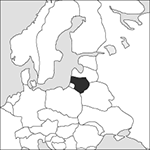
Source: MAPS IN MINUTES™ © RH Publications (1997)
Capital:
Vilnius
Area:
65,300 sq km (25,212 sq miles)
Population:
2,900,000 (2016 est)
Currency:
1 euro = 100 cents
Religions:
Roman Catholic 77.2%; Eastern Orthodox 4.1% ; Old Believer 0.8%
Ethnic Groups:
Lithuanian 84.1%; Polish 6.6%; Russian 5.8%
Languages:
Lithuanian (official); Russian; Polish; minority languages
International Organizations:
UN; OSCE; EU; NATO; Council of Europe; WTO
A Baltic country, lying between Latvia to the north, Belarus to the east, and Poland to the south.
Physical
Lithuania has just some 25 km (15 miles) of Baltic Sea coast, and is predominantly flat, though hilly in the east, where there are many lakes. The lowland plain is forested and fertile; it is drained by the Nemen and its tributaries.
Economy
Lithuania is agriculturally self‐sufficient, specializing in meat and milk production, but it depends on imports for supplies of energy and raw materials. There is some electricity production, but Lithuania relies on the unified grid of the Baltic region for much of its electricity supply. Mineral resources are varied, including various chemicals, iron ore, and oil. Lithuania’s main industries are machinery, consumer appliances, oil refining, and shipbuilding. Tourism is of growing importance.
History
Lithuania was a vast grand‐duchy during the Middle Ages, stretching at one time from the Baltic to the Black Sea and almost to Moscow. By 1569 it had united with Poland and was absorbed into Russia in 1795 in the Third Partition. After an uprising in 1863 the Lithuanian language was forbidden, but nationalist and strong Social Democrat movements developed from the 1880s. It was occupied by German troops (1915–18), and in March 1918 a German king was elected. He was deposed in November and a republic proclaimed. Bolshevik troops now invaded from Russia and a short Russo‐Lithuanian War ended in March 1920 with the Treaty of Moscow. This gave Lithuania German‐speaking Memel, but it failed to gain Vilna (the present capital Vilnius), which went to Poland. At first a democratic republic, its politics polarized and a neo‐Fascist dictatorship under Antanas Smetona was established in 1926. In October 1939 a Soviet‐Lithuanian Pact allowed Lithuania to claim Vilna, Memel having been lost to the Germans. In July 1940 the Assembly voted for incorporation into the Soviet Union; but the country was occupied by the Germans (1941–44), when its large Jewish population was almost wiped out. Re‐occupied by the Red Army in 1944, it became again a constituent Republic of the Soviet Union. In 1956 there were serious anti‐Soviet riots, ruthlessly suppressed. In March 1990 a unilateral declaration of independence was made. The Soviet Union at first responded by an economic blockade, but in May it agreed to negotiate, and in September 1991 recognized Lithuania’s independence. In December citizenship was restricted to those with ten years’ residence, a knowledge of the language and constitution, and a source of income. In 1992 a new constitution gave increased executive powers to the President; Algirdas Brazauskas, the former leader of the Lithuanian Communist Party, was elected. Valdas Adamkus, an independent, was elected President in 1998, but was defeated by Rolandas Paksas in 2003. However, Paksas was impeached for various criminal acts and removed from office; Adamkus was subsequently re‐elected as President. Lithuania joined NATO and the European Union in 2004. Economic problems led to violent protests in 2008. In 2009 Dalia Grybauskaitė was elected Lithuania’s first woman President. In 2016, the Peasants and Green Union (led by Ramūnas Karbauskis), a previously obscure party, won the general election having promised to stop the population decline. The country adopted the euro at the start of 2015. The same year NATO increased its military deployment in Lithuania to counter potential Russian aggression. In the 2016 general election, voter dissatisfaction with the established parties gave victory to the Peasant and Green Union, led by Saulius Skvernelis.
- polarization of light
- polarized plug
- polarized radiation
- polarized relay
- polarizer
- polarizing angle
- polarizing microscope
- polar molecule
- polar motion
- polar nuclei
- polarography
- Polaroid
- polaron
- polar orbit
- Polar Orbiting Passive Atmospheric Calibration Sphere
- polar plot
- polar plume
- polar ring galaxy
- Polar Satellite Launch Vehicle
- polar sequence
- polar solvent
- polar stratospheric cloud
- Polar units
- polar vector
- polar vortex